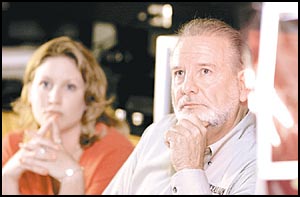Texas A & M at Corpus Christi professor searches for Sasquatch
Scientist to appear on Discovery Channel show
 By
Tricia Schwennesen Corpus Christi Caller-Times, Texas May 28, 2002
By
Tricia Schwennesen Corpus Christi Caller-Times, Texas May 28, 2002
Dr. Robert Benson
believes in evidence. The
Texas A&M University-Corpus Christi physics professor and director
of the university's Center for Bioacoustics won't allow himself to believe
in anything unless there is strong evidence.
Benson did not believe in Big Foot, which is why the world-renowned bioacoustician
was tapped by a Whitewolf Entertainment producer to analyze possible audio
evidence for a documentary co-produced by the Discovery Channel called, "Sasquatch: Legend Meets Science." "It's
interesting," he said Saturday, sitting in front of his audio equipment
on a short break from filming his segment of the documentary.
'It wasn't a hasty
decision'
The scientist,
who regularly studies the sounds of birds and marine mammals, had been
asked numerous times in the past decade to listen to recordings of sound
that some people said belonged to the controversial Sasquatch, but he
never gave them much consideration, he said.
Even when the Discovery Channel called he didn't immediately agree to listen to the audio recordings, but instead consulted with colleagues and the dean of the College of Science and Technology. "I weighed the pros and cons," he said. "It wasn't a hasty decision."
In the end he felt whatever he might contribute would be beneficial to the school, he said.
Benson received several audio tape recordings a couple of weeks ago that purported to capture the sound of the legendary animal. It's a scratchy recording of what sounds like whipping wind. In the foreground is the clear clip of a dog barking.
But it's the sound in the background he's been asked to identify - a low, drawn-out wailing like the moan of a movie banshee. Using special audio equipment, Benson will make a voice imprint of the sound, a graphical representation that can then be compared to other known sounds.
'Visual picture' of sound
"It's a visual picture of the sound, so we can make measurements of the temporal frequencies," he said. With the help of a graduate student, Benson is also gathering background material for comparison with such sounds as those of coyotes, wolves, elk and primates.
"This is a mammal, at least we suspect," he said. "We're still analyzing that."
So far, Benson's study hasn't yielded a concrete answer. He may take his work into a sound studio in the next couple of weeks if he is able to learn more about the unidentified cry."There is a whole range of things that it might possibly be," he said. "In all possibilities, there is the possibility that this could be human."
It was a trail of human-like footprints found in a desolate area of the Arctic in 1992 that prompted Minneapolis-based producer Doug Hajicek to pursue the project. While filming another project for the Canadian government, Hajicek and his guide stumbled on the trail and followed it for about a mile.
'No skin'
"They were
17- to 18-inch footprints that traveled through sand, tundra and gravel,"
he said. "I was amazed. I saw it with my own eyes." But
the question remained. What had created the trail in the first place?
His mind turned to a cover story about the Sasquatch that he had seen as a young man in the magazine Boys Life. "We considered everything that could have made this and we couldn't figure it out," he said. "It was fresh." With the footage of the footprints, Hajicek embarked on 18 months of field research, talking with scientists, exploring claims of evidence and checking out other documentaries of the phenomenon, he said.
What he found was little science. "Wouldn't it be interesting to put the evidence in front of mainstream scientists and forensic scientists and let them go at it," he said that he wondered. "Here's a case where there are photos of this thing and there is film of this thing but there's no body, no skin."
'Anecdotal evidence'
"There's far more evidence to this creature's existence, I'd say by a thousandfold, than to the Loch Ness monster," Hajicek said. So, the evidence is being presented to scientists like Benson. The greatest piece of evidence may be a 1996 film of an unidentified subject running across a rocky mountain in Washington state near the Canadian border, he said.
"We are doing a first time, complete forensic measuring of the Memorial Day film," Hajicek said where height, size, speed of the being and gait will be determined. "That's still anecdotal evidence but maybe more scientists will get involved to put this mystery to rest and it really does need to be put to rest."
Hajicek and his crew are about a third of the way done filming the project, which he says will cost less than $250,000. The one-hour special that pits science against myth is set to air in November and is being filmed with a 35mm camera for high definition television production.
'It might be negative'
Benson is one of more
than a dozen experts from mainstream sciences such as forensics, primatology
and behavioral science to examine potential evidence that could prove
or disprove the mammoth being's existence. For
now, Benson said he can only address the acoustical evidence. "We
have recordings but what the source might be, we don't know," he
said. "It is evidence but it might be negative evidence."
(C) Corpus Christi Caller-Times
Contact Tricia
Schwennesen at 886-3618 or schwennesent@caller.com
http://www.caller.com/ccct/local_news/article/0,1641,CCCT_811_1172768,00.html
Back
to Newspaper & Magazine Articles
Main
Portions of this
website are reprinted under the Fair Use Doctrine of International Copyright
Law as educational material without benefit of financial gain. This proviso
is applicable throughout the entire website at www.bigfootencounters.com
Bigfoot Encounters -
We reserve the right to edit news and documentaries.